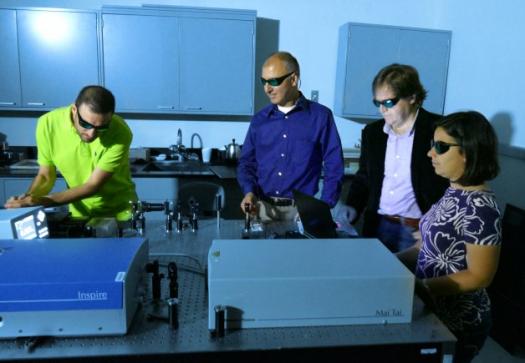Army solar cell breakthrough results in patent

U.S. Army researchers have developed a tiny photovoltaic solar cell for the conversion of light energy into electrical energy that it resulted in a patent.
The patent reveals a new kind of photovoltaic solar cell with significantly reduced size and cost compared with current solar cells.
Dr. Michael Scalora, a research physicist at the U.S. Army Aviation and Missile Research, Development and Engineering Center, or AMRDEC, at Redstone Arsenal, Alabama, described the invention as a "breakthrough," which he hopes will be the basis for further technological progress.
Scalora is a co-inventor of the solar cell.
"Low-cost, compact, flexible and efficient solar cells are destined to impact all sorts of Department of Defense applications, as lightweight solar panels will eventually power all kinds of equipment, particularly in remote, inaccessible areas," he said. "The key to the development of efficient, compact solar cells are advances in nanotechnology, nano-fabrication techniques and thin-film production.
"Current solar cells based on single crystal [pure] silicon have advanced significantly over the years."
A photovoltaic, or PV, solar cell is a specialized semiconductor diode that converts visible light into a direct current. The PV cell allows solar light to be absorbed efficiently by a material and then converted into charge carriers that generate an electrical current, known as a photocurrent.
"The process that led to our patent was inaugurated in the late 1990s, when we began a detailed study of the optical properties of noble metals like silver, gold and copper," Scalora said. "Our invention inserts layers of metals like silver and gold between the various semiconductor layers resulting in a combined thickness of only a few hundred nanometers."
A piece of paper is about 100,000 nanometers thick.
"This is a great example of one of our programs that transitioned to the military and private sector," said Wayne Davenport, optical sciences function chief of the Weapons Development and Integration Directorate and Scalora's supervisor. "Though the foundational effort began in the 1990s, it has found applications over 20 years later."
The next generation of solar cells has begun to address costs, materials and flexibility problems, in addition to reducing the thickness of the PV cell. The newly-designed, multilayer stack has dramatically reduced the size of a PV cell, about 1,000 times thinner than that of the previous 100 to 200 microns, which was about the size of a grain of sand.
The inventors designed the cell to overcome current solar panel problems such as wear out, damage and stress introduced to the structure by heating. Damage and heating in a solar panel is produced by absorption of the high content of ultraviolet and infrared radiation from the sun.
UV and IR radiation can either be reflected by the solar panel cells to avoid damage to the structure or absorbed in materials having the appropriate bandgaps to generate an electrical photocurrent.
As a result of the cell's inherent geometry, the absorption rate of sunlight is not affected by the angle between the sun and the cell's multilayer stack. Thus, solar tracking systems are not required to improve the efficiency of this new PV cell. The reduced transparency allows the layers of the PV cell to almost completely absorb incoming sunlight.
A critical problem with radiation is the mismatch between the broad wavelength band available in sunlight and the narrow wavelength band associated with semiconductor energy bandgap. If light was allowed to enter the cell, this mismatch would cause a loss of power. By using the photonic bandgap approach developed in this invention, solar cells will operate more efficiently than presently possible.
The inventors of photonic bandgap solar cells altered the multilayer stack of the solar cell using geometrical parameters and optical properties of noble metals allowing direct control of energy absorption, reflection and transmission spectra.
"As with many basic research projects, the near-term benefits are sometimes yet undefined but are clearly worth the investment," Davenport said. "The Army's research laboratories at AMRDEC continue a legacy of high quality research projects and I expect to see many more of these type projects transition to the Warfighter in the future."


































